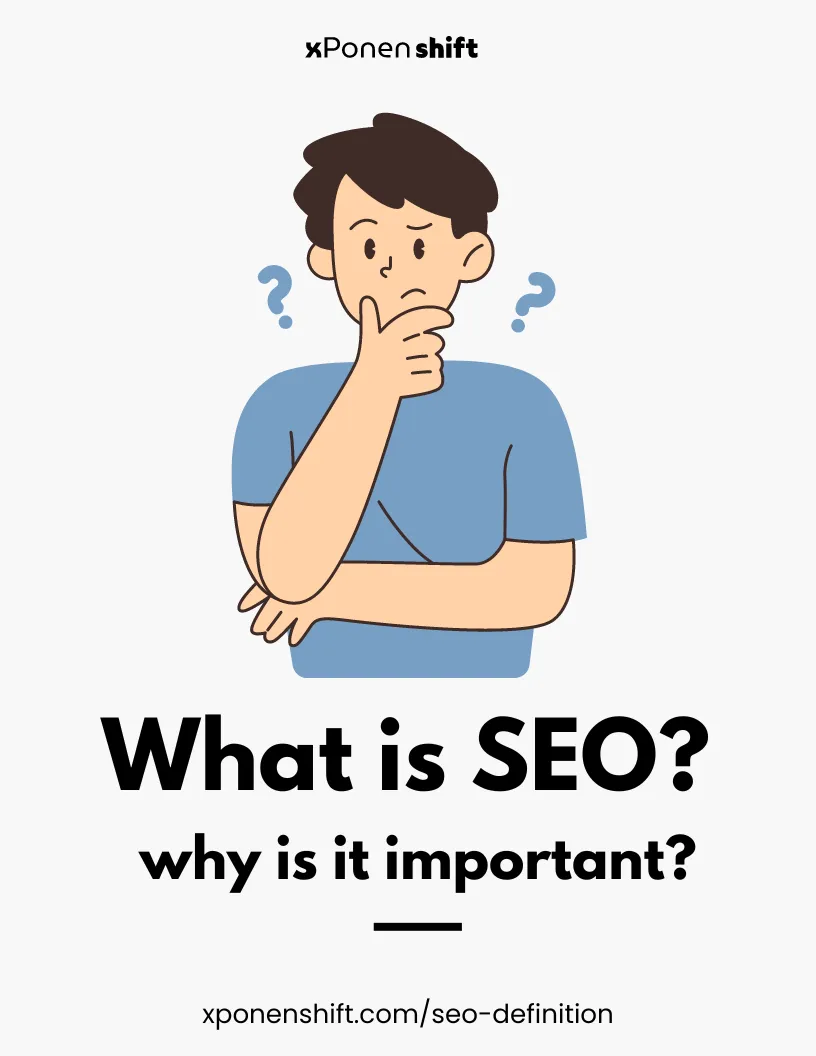- admin
- Introduction to SEO
- 0 Comments
- 130 Views
Search Engine Optimization (SEO) is the process of improving the visibility of a website or a web page in search engine results.
Essentially, it’s about making your website more attractive to search engines like Google so that they rank it higher in their search results.
This is important because the higher your website ranks, the more likely it is to be clicked on by users.
Think of it like this: imagine you’re in a library looking for a book. The books placed at eye level or on the first few shelves are more likely to be noticed and picked up.
SEO Logic
Similarly, websites that appear on the first page of search engine results are more likely to get visitors. The goal of SEO is to increase organic (non-paid) traffic to your website, ultimately driving more visitors, leads, and potential customers to your business.
To achieve this, businesses employ various strategies such as optimizing keywords, creating high-quality content, improving website performance, and building backlinks from reputable sources.
Explaining SEO in a More Laid-back Way
Search Engine Optimization (SEO) is the practice of optimizing a website or online content to increase its visibility and ranking on search engine results pages (SERPs).
This process involves a variety of techniques aimed at improving both the quality and quantity of organic (non-paid) traffic to the website from search engines like Google, Bing, and Yahoo.
Essentially, SEO aims to make your website more attractive and relevant to search engines, thereby improving its chances of being ranked higher for relevant keywords and phrases.
This involves optimizing various on-page elements such as titles, meta descriptions, headings, and content, as well as off-page factors such as backlinks and social signals.
The ultimate goal of SEO is to enhance the user experience, provide valuable content, and ultimately drive more targeted traffic to the website, resulting in increased visibility, brand awareness, and potential conversions.
Is there a difference between Google, Bing and Yahoo SEO?
Yes, there are differences between SEO for Google, Bing, and Yahoo, primarily in terms of algorithms, ranking factors, and user behavior. Here’s a brief overview of some key distinctions:
Algorithms
An algorithm is a set of rules or instructions followed by a computer program to solve a problem or perform a task.
In the context of search engines like Google, Bing, and Yahoo, algorithms are complex formulas used to determine the relevance and ranking of web pages in search results.
- Google: Google’s algorithm, including updates like Panda, Penguin, and more recently, BERT, prioritizes high-quality content, relevancy, user experience, and authority. Google tends to place a strong emphasis on user intent and semantic search.
- Bing: Bing’s algorithm focuses on similar factors as Google but may weigh certain elements differently. Bing emphasizes factors such as domain age, exact match domains, and social signals more than Google.
- Yahoo: Yahoo’s search algorithm is powered by Bing, so it shares many similarities with Bing in terms of ranking factors and results. However, Yahoo may also consider factors specific to its own search engine.
Ranking Factors
Ranking factors are the criteria or signals that search engines use to assess the quality, relevance, and authority of web pages and determine their position in search results.
These factors include elements such as content quality, backlink profile, user experience, page speed, mobile-friendliness, and more.
- Google: Google considers hundreds of ranking factors, including but not limited to, content quality, backlink profile, page speed, mobile-friendliness, user engagement metrics, and user experience signals.
- Bing: Bing also considers many of the same ranking factors as Google, but may place more emphasis on factors like domain age, exact match domains, and social signals.
- Yahoo: Since Yahoo’s search results are powered by Bing, it relies on similar ranking factors, with some potential differences based on Yahoo’s own algorithms and preferences.
User Behavior
User behavior refers to how individuals interact with search engines and websites when conducting online searches.
This includes factors such as search queries, click-through rates, dwell time (time spent on a page), bounce rates, and engagement with search results and website content.
User behavior data helps search engines understand the relevance and usefulness of web pages and influences search rankings accordingly.
- Google: Google is the dominant search engine worldwide, with the majority of internet users using Google for their search queries. Users often trust Google’s search results and expect relevant and high-quality content.
- Bing: Bing has a smaller market share compared to Google but still has a significant user base, especially in certain demographics and regions. Bing users may have different preferences and search behaviors compared to Google users.
- Yahoo: Yahoo’s search engine is less popular than Google or Bing but still attracts a notable number of users, particularly in specific regions or for specific types of searches.
While there are differences between SEO for Google, Bing, and Yahoo, many best practices overlap. Ultimately, focusing on creating high-quality, relevant content, optimizing for user experience, and earning authoritative backlinks can improve rankings across all search engines.
However, it’s essential to understand the unique algorithms and preferences of each search engine to tailor your SEO strategy effectively.
How do we determine SEO goals?
Setting SEO goals involves identifying what you want to achieve through your search engine optimization efforts.
The first step is to establish clear and measurable objectives that align with your overall business goals.
These goals could include increasing website traffic, improving keyword rankings, boosting online sales or conversions, enhancing brand visibility, or expanding into new markets.
Once you’ve defined your goals, it’s important to prioritize them based on their importance to your business and the resources available.
For example, if your primary objective is to increase online sales, you may prioritize improving keyword rankings for product-related searches and optimizing the conversion funnel on your website.
Conversely, if brand awareness is your main focus, you might prioritize increasing organic visibility and engagement on social media platforms.
Additionally, it’s essential to set specific, achievable, and time-bound targets for each goal, allowing you to track progress and adjust strategies accordingly.
Regularly monitoring key performance indicators (KPIs) such as organic traffic, keyword rankings, conversion rates, and engagement metrics can help you evaluate the effectiveness of your SEO efforts and make data-driven decisions to optimize performance further.
Examples of SEO goals in various businesses
Here are examples of SEO goals for different types of businesses:
E-commerce Business
Goal: Increase online sales by 20% within the next six months. Strategy: Optimize product pages for relevant keywords, improve website speed and mobile-friendliness, implement structured data markup for rich snippets in search results, and launch targeted email marketing campaigns to drive traffic and conversions.
Service-Based Business (e.g., Digital Marketing Agency)
Goal: Generate 30% more leads through organic search within the next quarter. Strategy: Focus on local SEO tactics such as optimizing Google My Business profile, creating location-specific landing pages, obtaining high-quality backlinks from industry-related websites, and regularly publishing informative blog content targeting relevant keywords.
Brand Awareness Campaign
Goal: Increase organic brand visibility by 50% across search engines and social media platforms in the next year.
Strategy: Develop a comprehensive content marketing plan including blog posts, infographics, videos, and social media posts to showcase brand expertise and engage the target audience.
Implement on-page SEO techniques to optimize content for search engines and promote content through social sharing and influencer collaborations to expand reach and brand awareness.
Local Business (e.g., Restaurant)
Goal: Drive 25% more foot traffic to the restaurant within the next six months.
Strategy: Implement local SEO tactics such as optimizing Google My Business listing with accurate business information, encouraging customer reviews and testimonials, creating location-specific landing pages targeting local keywords, and participating in local community events or sponsorships to increase visibility and attract nearby customers.
Each of these examples demonstrates how businesses can set specific, measurable, and achievable SEO goals tailored to their unique objectives and target audience, helping them maximize their online presence and achieve tangible results.
How to measure the success of your SEO efforts?
Measuring the effectiveness of your SEO activities involves tracking various key performance indicators (KPIs) to evaluate your website’s performance in search engine results and its impact on overall business objectives. Some essential metrics to consider include:
- Organic Traffic: Monitor the number of visitors coming to your website through organic search channels. Increasing organic traffic indicates improved visibility and relevance in search engine results.
- Keyword Rankings: Track the rankings of target keywords and phrases relevant to your business. Rising rankings for important keywords demonstrate improved search visibility and can lead to increased organic traffic.
- Conversion Rate: Measure the percentage of website visitors who complete desired actions, such as making a purchase, filling out a contact form, or subscribing to a newsletter. Improvements in conversion rate indicate the effectiveness of your SEO efforts in driving relevant traffic and engaging users.
- Click-Through Rate (CTR): Evaluate the percentage of users who click on your website’s link in search engine results. A higher CTR suggests that your title tags and meta descriptions are compelling and relevant to users’ search queries.
- Bounce Rate: Monitor the percentage of visitors who navigate away from your website after viewing only one page. A lower bounce rate indicates that visitors find your content valuable and engaging, leading to longer sessions and potentially higher conversion rates.
- Backlink Profile: Assess the quantity and quality of backlinks pointing to your website from other reputable sources. A diverse and authoritative backlink profile can improve your website’s authority and trustworthiness in the eyes of search engines.
- Return on Investment (ROI): Calculate the financial return generated from your SEO activities compared to the investment made. This may include factors such as increased revenue, cost savings from reduced advertising spend, or improved brand visibility and customer retention.
By regularly monitoring these metrics and analyzing trends over time, you can gauge the effectiveness of your SEO strategies, identify areas for improvement, and make data-driven decisions to optimize your website’s performance in search engine results.
How to achieve SEO goals and are there any campaigns that need to be done?
Achieving SEO goals requires a strategic approach and implementation of various campaigns aimed at improving website visibility, relevance, and authority in search engine results.
Some key campaigns and tactics to consider include:
1. On-Page Optimization
Optimize website elements such as titles, meta descriptions, headings, and content to include target keywords and provide valuable, user-friendly information.
Ensure that your website is well-structured, easy to navigate, and optimized for mobile devices.
2. Content Marketing
Develop a content strategy focused on creating high-quality, relevant, and engaging content that addresses the needs and interests of your target audience.
This may include blog posts, articles, infographics, videos, and other multimedia content optimized for search engines and social sharing.
3. Link Building
Build a diverse and authoritative backlink profile by obtaining links from reputable websites and industry-related sources.
This can be achieved through outreach campaigns, guest blogging, content partnerships, and participation in online communities or forums.
4. Local SEO
If your business serves a specific geographic area, optimize your online presence for local search by claiming and optimizing your Google My Business listing, ensuring consistent NAP (name, address, phone number) information across online directories, and obtaining positive reviews from satisfied customers.
5. Technical SEO
Address technical issues that may impact your website’s performance in search engine results, such as site speed optimization, mobile responsiveness, HTTPS security, crawlability, and indexability. Use tools like Google Search Console to identify and fix any errors or issues affecting your website’s visibility.
6. Social Media Integration
Leverage social media platforms to amplify your content, engage with your audience, and build brand awareness. Encourage social sharing of your content to increase visibility and attract potential visitors and customers.
7. Monitoring and Optimization
Continuously monitor your website’s performance using analytics tools to track key metrics such as organic traffic, keyword rankings, conversion rates, and engagement. Analyze the data to identify trends, opportunities, and areas for improvement, and adjust your strategies accordingly to maximize results.
By implementing these campaigns and tactics effectively, you can improve your website’s SEO performance, increase organic traffic, and ultimately achieve your SEO goals. Remember that SEO is an ongoing process that requires dedication, patience, and adaptation to evolving search engine algorithms and user behaviors.
Example of SEO campaign for local business
Here’s an example timeline for a local SEO campaign for a flower shop in a specific area:
Month 1: Research and Planning
- Week 1: Conduct keyword research to identify relevant local keywords related to the flower shop’s products and services, as well as location-specific keywords.
- Week 2: Perform a competitive analysis to assess the local SEO strategies of competing flower shops and identify opportunities for differentiation.
- Week 3: Develop a content plan for location-specific landing pages, blog posts, and social media content targeting local keywords and addressing customer needs and interests.
- Week 4: Set specific, measurable, and time-bound SEO goals for the campaign, such as increasing organic traffic, improving local search rankings, and driving foot traffic to the flower shop.
Month 2-3: On-Page Optimization
- Week 1-2: Optimize the flower shop’s website for local search by updating meta titles, descriptions, and headers with relevant keywords and location modifiers.
- Week 3-4: Create and optimize Google My Business (GMB) listing with accurate business information, high-quality photos, and compelling descriptions. Ensure consistent NAP (name, address, phone number) across online directories and listings.
Month 4-5: Content Creation and Outreach
- Week 1-2: Publish location-specific landing pages on the flower shop’s website targeting local keywords and highlighting products, services, and promotions.
- Week 3-4: Develop and publish blog posts and articles addressing local events, floral trends, gardening tips, and customer testimonials. Share content on social media platforms and engage with local community groups and influencers.
- Week 5-6: Implement a local link building campaign to acquire backlinks from local businesses, event organizers, and community organizations. Offer to sponsor local events or provide floral arrangements for community gatherings to earn mentions and backlinks.
Month 6: Monitoring and Optimization
- Week 1-2: Monitor the performance of local SEO efforts using tools like Google Analytics, Google Search Console, and local SEO software.
- Week 3-4: Analyze key metrics such as organic traffic, keyword rankings, GMB insights, and customer reviews. Identify areas for improvement and adjust strategies accordingly.
- Week 5-6: Continue to refine and optimize local SEO campaigns based on performance data, user feedback, and changes in local search algorithms. Stay engaged with the local community through social media interactions, events, and promotions.
By following this timeline and implementing a comprehensive local SEO strategy, the flower shop can improve its online visibility, attract more local customers, and grow its business in the targeted area.
Is an SEO campaign guaranteed to succeed?
SEO campaigns, like any marketing initiative, do not guarantee immediate or guaranteed success. Success in SEO depends on various factors, including the competitiveness of the industry, the quality of your website and content, the effectiveness of your strategies, and the consistency of your efforts over time.
While implementing SEO best practices and following recommended guidelines can improve your website’s visibility and rankings in search engine results, there are no guarantees of achieving specific outcomes.
Additionally, the landscape of search engine algorithms is constantly evolving, which means that what works today may not necessarily work tomorrow.
SEO requires ongoing monitoring, adaptation, and optimization to keep up with changes in search engine algorithms, user behavior, and industry trends.
It’s essential to set realistic expectations and understand that SEO is a long-term investment that requires patience, persistence, and continuous improvement.
While some businesses may see significant results relatively quickly, others may take longer to achieve their SEO goals.
Success in SEO often comes from a combination of factors, including strategic planning, quality content creation, technical optimization, link building, and regular performance monitoring and refinement.
How much money do I need to allocate for the SEO campaign?
The budget required for an SEO campaign can vary depending on various factors such as the scope of work, competitiveness of the industry, and the specific goals of the campaign.
Here’s an approximate breakdown of costs for both hiring an agency and doing it yourself:
1. Hiring an Agency:
- Initial SEO Audit and Strategy Development: $500 – $5,000+
- Monthly Retainer Fee: $1,000 – $10,000+ per month (depending on the agency’s expertise and level of service)
- Content Creation (blog posts, articles, etc.): $100 – $500+ per piece
- Link Building and Outreach: $500 – $2,000+ per month (if included in the agency’s services)
- Technical SEO Optimization: $500 – $2,000+ (one-time or ongoing fee)
- Reporting and Analysis: Included in the retainer fee, but additional fees may apply for in-depth analysis or custom reports
Total Estimated Cost for Hiring an Agency: $2,600 – $19,500+ per month (and potentially higher for larger-scale campaigns or more competitive industries)
2. Doing It Yourself:
- SEO Tools and Software Subscriptions (e.g., SEMrush, Ahrefs, Moz): $100 – $500+ per month
- Content Creation (if outsourcing to freelancers or agencies): $100 – $500+ per piece
- Website Maintenance and Optimization (if not included in your regular expenses): $500 – $1,000+ per month
- Paid Advertising (optional, but may complement SEO efforts): Budget varies depending on platform and campaign goals
Total Estimated Cost for DIY SEO: $700 – $2,000+ per month (excluding labor costs if you handle SEO tasks yourself)
Keep in mind that these are rough estimates, and actual costs may vary based on your specific needs, the level of expertise required, and the quality of services or tools you choose.
It’s essential to assess your budget, goals, and resources carefully before deciding whether to hire an agency or manage SEO efforts in-house.
Additionally, consider the potential return on investment (ROI) of your SEO campaign in terms of increased website traffic, leads, and revenue when determining your budget allocation.
So, what’s the conclusion on SEO? And is it important for businesses?
SEO, or Search Engine Optimization, is crucial for businesses looking to establish a strong online presence and attract organic traffic to their websites.
By optimizing their websites and content to rank higher in search engine results, businesses can increase their visibility, reach their target audience more effectively, and ultimately drive more traffic, leads, and conversions.
In essence, SEO is about ensuring that your website is easily discoverable by potential customers when they search for relevant products, services, or information online.
By investing in SEO, businesses can improve their competitiveness, enhance brand awareness, and achieve long-term growth and success in the digital landscape.



